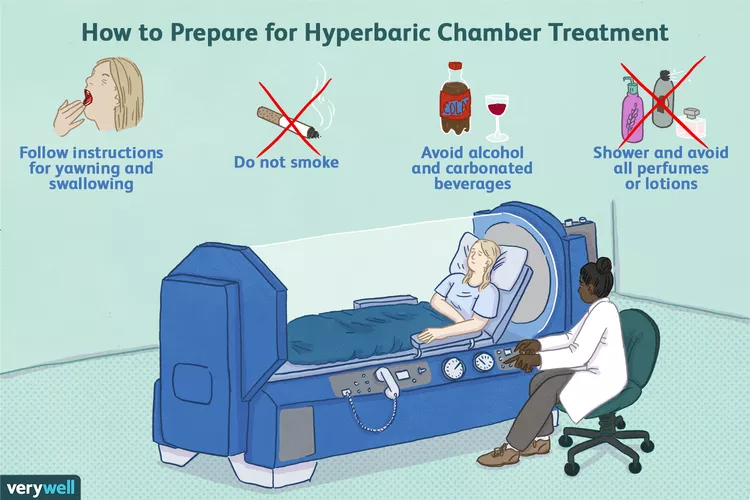Hyperbaric chamber therapy is a noninvasive medical treatment that boosts your body's oxygen levels. Known medically as hyperbaric oxygen therapy (HBOT), it treats carbon monoxide poisoning, decompression sickness, and slow-healing wounds.
HBOT involves sitting in a hyperbaric chamber—an enclosed space filled with high-pressure oxygen— and breathing. This allows your lungs to take in more oxygen, thereby increasing circulating oxygen in your bloodstream.
This article explores hyperbaric chamber therapy. It discusses how HBOT works and what it treats. It also explains the possible side effects of hyperbaric treatment and whether or not insurance covers it.
A hyperbaric chamber is a high-pressurized, enclosed space filled with pure oxygen. There are two types of hyperbaric chambers:
- 1- Monoplace hyperbaric chambers: Clear acrylic tubes are designed for one person to lie down or recline. High-pressure oxygen is delivered into the tube.
- 2- Multiplace hyperbaric chambers: This is a small pressurized room (similar to an airplane cabin) with multiple chairs. A mask or a lightweight, transparent hood placed over the head delivers high-pressure oxygen to each individual.
The air pressure inside a hyperbaric chamber is two or three times greater than in a typical room. This improves oxygen absorption and speeds healing.
How Does Hyperbaric Oxygen Therapy Work?
Hyperbaric chamber therapy, also known as recompression therapy, works by providing a controlled stream of oxygen, an essential element for human life. Oxygen is absorbed by the lungs, where it enters the bloodstream, travels to the heart, then circulates to all of the tissues in your body.
HBOT delivers pure oxygen under high air pressure, which helps the body take in more healing oxygen. This, in turn, allows for higher oxygen concentrations in the blood and other body fluids. Oxygen-rich fluids travel through different organ systems, helping to repair damaged tissues.
For example, higher levels of oxygen in cerebral spinal fluid—the fluid that surrounds the brain and spinal column—may be helpful for regenerating neurons after a stroke. A greater concentration of oxygen in the lymphatic fluid may help to clear waste from lymph nodes and bolster your immune system.
Conditions Treated by Hyperbaric Oxygen Therapy
HBOT is used to treat many different medical conditions and injuries that benefit from increased oxygen levels in the tissues.
Some of the common uses for hyperbaric oxygen therapy that are often covered by insurance include:
- Arterial gas embolism (air bubbles in the blood vessels)
- Carbon monoxide poisoning
- Cyanide poisoning
- Decompression sickness
- Specific types of non-healing wounds, such as diabetic wounds
- Gas gangrene
- Intracranial abscess
- Tissue damage from radiation therapy
- Osteomyelitis
- Compromised skin grafts or flaps
- Severe anemia
- Burns
- Crushing injury
- Sudden deafness
- Sudden, painless vision loss
Several other types of injuries and illnesses are said to benefit from HBOT. However, there is a lack of clinical evidence to back up many of these claims.
Summary
Hyperbaric oxygen therapy helps to increase the amount of oxygen in your body. It involves sitting or lying down in a high-pressurized enclosure known as a hyperbaric chamber. A session takes about two hours.
HBOT is used to treat carbon monoxide poisoning, severe burns, slow-healing wounds, and decompression sickness. It is also used in alternative medicine to treat neurological conditions, depression, and heart disease, though more research is needed to confirm its effectiveness.
Hyperbaric chamber therapy is typically pleasant and relaxing, though air pressure changes can cause ear and sinus pressure. In rare cases, HBOT can cause a ruptured eardrum, collapsed lung, or oxygen poisoning.


